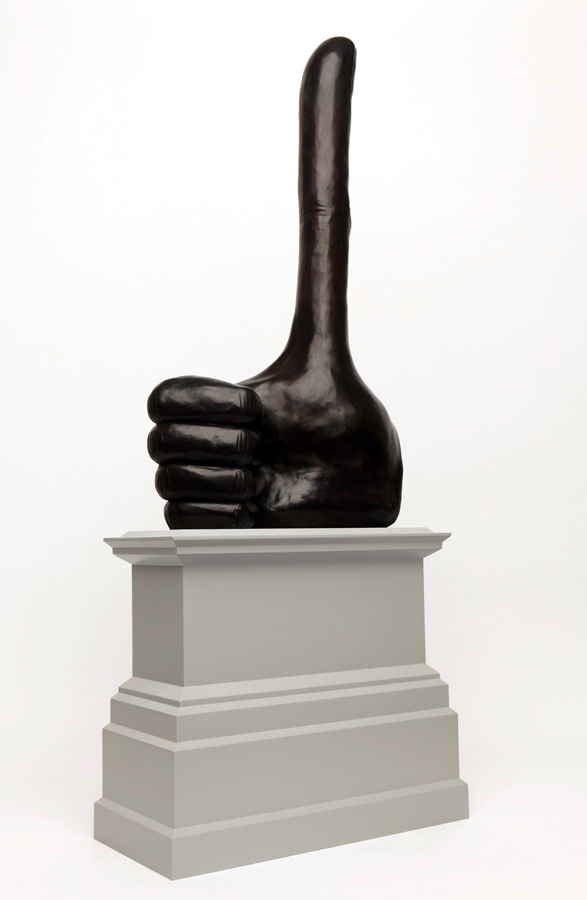What do Hans Haacke and David Shrigley have in common? The former is one of the godfathers of political conceptual art, the latter one of Britain’s finest exponents of art as a vehicle for existentially absurd deadpan humour – so not much, you’d think. But both of them have just been commissioned to produce sculptures for Trafalgar Square’s ‘fourth plinth’ – the otherwise vacant pedestal at the northwest corner of London’s most well known public space, which over the last 15 years has become the site for an annual public commission, funded by the Mayor of London and the Arts Council.
The commissions announced for 2015 and 2016, Haacke and Shrigley respectively, might seem poles apart, but underlying them is an attitude that now seems to dominate the culture of public art in the UK: an attitude that favours public art as either a self-conscious deprecation of the status of public art – not very serious, not very important – or conversely, as an opportunity for a bit of earnest social commentary about the issues of the day.
They’re the sculptural equivalent of a Live Aid concert
Shrigley’s Really Good is a large cartoonish fist doing the ‘thumbs up’ gesture, but in which the thumb is elongated absurdly skyward. As Shrigley pieces go, it’s a good ’un, neatly condensing the artist’s usual schtick – credulous optimism forever sunk by a cackling, blackhearted comedy of human failure. ‘It is my hope that this piece would make Trafalgar Square, London, the UK and the world a much better place. And it would be quite a cost-effective way of doing it,’ says Shrigley, his tongue lost somewhere in his cheek.
If Shrigley ventriloquises the idiot-speak of social amelioration that now dominates arts policy in the UK, then Haacke’s Gift Horse reminds us that the only thing public art likes more than flattering the public by satirising its own pointlessness is condescending to the public by lecturing it about serious contemporary ‘issues’. So Haacke’s clodhopping, boorishly didactic work is a bronze horse’s skeleton, which is supposed to contrast with the statue of King George IV on horseback on the opposite side of the square. Fixed to the horse’s foreleg will be an electronic display strip, displaying ‘live the ticker of the London Stock Exchange, completing the link between power, money and history’, according to the work’s droning publicity text. Capitalism is going to ruin us! Yeah! All this pomp and splendour that surrounds you is built on the sand of the stockmarket! Wooh! We are the 99%! And this under the indulgent gaze of Conservative Mayor Boris Johnson…
Haacke’s horse isn’t the first work for the fourth plinth to take on ‘issues’, of course. Marc Quinn’s Alison Lapper Pregnant (2005) was meant to make us think about disabled people and beauty; Yinka Shonibare’s Ship in a Bottle (2010) was meant to make us think about the history of British imperial power; Elmgreen & Dragset’s Powerless Structures, fig. 101 (2012) was meant to make us think a bit about war, and y’know, innocence and stuff. They’re the sculptural equivalent of a Live Aid concert.
What goes on in the internal discussions of the fourth plinth commissioning group, made up as it is of London artworld power-people such as Whitechapel director Iwona Blazwick, artist Jeremy Deller and Frieze’s Matthew Slotover? These are people who do smart, interesting stuff in their normal roles, but here appear to imagine the public as a strange fusion of bored teenager and angry mob; restless, distracted, excited by bold shapes and colours and thoughtless political truisms about the state of the world. Or is it merely that the priority is always for a quirky, photogenic landmark to provide some PR gloss for Boris’s increasingly sterile, expensive, non-dom-friendly and overregulated city?
Either way, such preoccupations with audience management and second-guessing have little to do with what might actually be the most interesting work of art, in and for itself, and what’s striking is that it’s usually the genuinely open and unpredictable work that gets left on the drawing board. So Mark Leckey’s proposed Larger Squat Afar, a bizarre recombining of elements copied from all the other statues on the square, might have offered the chance for an audience to puzzle and reflect on such subjects as the history of sculpture, the purpose of public monuments, or a culture now driven by remixing and editing, or… or a whole bunch of ideas led by an artist’s insights and interests, rather than by the dull managerial need of officials to please, placate and patronise us. But instead, big, loud and didactic win every time. Which is ironic, since so many fourth plinth works are made out to be somehow critical of the bad old days of traditional monumentalism – which was big, loud and, um, didactic…
This article was first published in the April 2014 issue.
